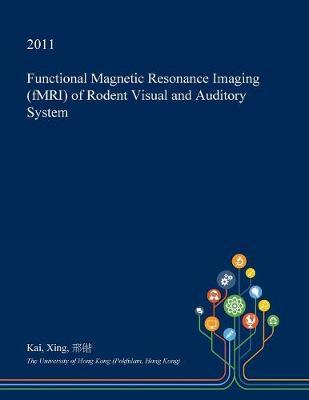Overview
This dissertation, Functional Magnetic Resonance Imaging (fMRI) of Rodent Visual and Auditory System by Kai, Xing, 邢锴, was obtained from The University of Hong Kong (Pokfulam, Hong Kong) and is being sold pursuant to Creative Commons: Attribution 3.0 Hong Kong License. The content of this dissertation has not been altered in any way. We have altered the formatting in order to facilitate the ease of printing and reading of the dissertation. All rights not granted by the above license are retained by the author. Abstract: Functional MRI or Functional Magnetic Resonance Imaging (fMRI) is a type of specialized MRI scan which measures the hemodynamic response related to neural activity in the brain or spinal cord of humans and animals. Due to its relatively low invasiveness, absence of radiation exposure, and relatively wide availability, functional MRI has come to dominate the brain mapping field since the early 1990s. The objective of this thesis work is to develop and apply functional MRI methods at 7 Tesla, for in vivo investigation of rodent visual and auditory system. Firstly, the development of the rat visual pathway was studied by blood oxygenation level-dependent (BOLD) contrast from the time of eyelid opening (P14) to adulthood (P60) in normal rat brain. By studying BOLD-fMRI measurements in the normal brain superior colliculus (SC), we determined that the regional BOLD response undergoes a systematic increase in amplitude especially over the third postnatal week. Secondly, the potential for plasticity of the rodent superior colliculus (SC) was studied using BOLD fMRI. By studying BOLD-fMRI measurements in the SC of three groups of rats (normal, HI-injured with left SC partially damaged and HI-injured with left SC completely damaged), we can evaluate the extent of plastic changes, compensatory and transneuronal plasticity after varying degrees of SC injury. We also applied BOLD-fMRI using very short repetition time (TR) of 0.2s on rats to measure the difference in response temporal dynamics between the SC and LGN, which has not been measured conclusively or with high temporal resolution. The primary finding in this study is that there is an approximately 0.8s difference between the BOLD responses of the rat contralateral SC and LGN to the visual stimuli. In addition, the amplitude of the SC response is larger than that of the LGN. Thirdly, BOLD-fMRI is used to measure the SC hemodynamic responses, in normal adult Sprague-Dawley (SD) rats, during a dynamic visual stimulus similar to those used in long-range apparent motion studies. The stimulation paradigm mimic effective speeds of motion between 7 and 164?/s, the results suggest that the SC is sensitive to slow moving visual stimuli but the hemodynamic response is reduced at higher speeds. Finally, BOLD-fMRI is used to study hemodynamic response temporal dynamics in the superior colliculus (SC) and inferior colliculus (IC) following visual and auditory associated stimulation. Our results show the baselines of SC BOLD signal (in two sides) increase during the ON period of auditory stimulation, which demonstrate that auditory stimulation can increase ROI activation signal intensity in superior colliculus (SC). The previous dominant theory is that individual senses each have separate areas of the brain dedicated to processing each sense, while the individual sense perceptions are integrated together to produce a multi-sensory experience. As a result of new research over the past several years, however, this view has been challenged by studies showing that processing in the visual area of the brain can be directly influenced by hearing and touch. All these discoveries represent a new view of how the brain is actually organized. DOI: 10.5353/th_b4784993 Subjects: Eye - Magnetic resonance imagingVisual pathways - Magnetic resonance imagingEar - Magnetic resonance imagingAuditory pathways - Magnetic resonance
Full Product Details
Author: Kai Xing ,
邢锴
Publisher: Open Dissertation Press
Imprint: Open Dissertation Press
Dimensions:
Width: 21.60cm
, Height: 0.50cm
, Length: 27.90cm
Weight: 0.231kg
ISBN: 9781361292334
ISBN 10: 1361292334
Publication Date: 26 January 2017
Audience:
General/trade
,
General
Format: Paperback
Publisher's Status: Active
Availability: Temporarily unavailable

The supplier advises that this item is temporarily unavailable. It will be ordered for you and placed on backorder. Once it does come back in stock, we will ship it out to you.



